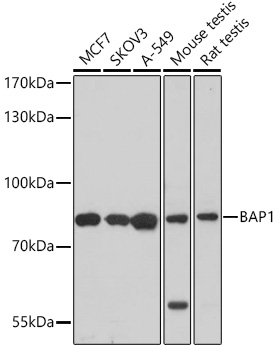Signal Transduction Antibodies 3
Anti-BAP1 Antibody (CAB6533)
- SKU:
- CAB6533
- Product Type:
- Antibody
- Reactivity:
- Human
- Reactivity:
- Mouse
- Reactivity:
- Rat
- Host Species:
- Rabbit
- Isotype:
- IgG
- Antibody Type:
- Polyclonal Antibody
- Research Area:
- Signal Transduction
Description
| Antibody Name: | Anti-BAP1 Antibody |
| Antibody SKU: | CAB6533 |
| Antibody Size: | 20uL, 50uL, 100uL |
| Application: | WB IHC IF |
| Reactivity: | Human, Mouse, Rat |
| Host Species: | Rabbit |
| Immunogen: | Recombinant fusion protein containing a sequence corresponding to amino acids 460-729 of human BAP1 (NP_004647.1). |
| Application: | WB IHC IF |
| Recommended Dilution: | WB 1:500 - 1:2000 IHC 1:50 - 1:200 IF 1:50 - 1:200 |
| Reactivity: | Human, Mouse, Rat |
| Positive Samples: | MCF7, SKOV3, A-549, Mouse testis, Rat testis |
| Immunogen: | Recombinant fusion protein containing a sequence corresponding to amino acids 460-729 of human BAP1 (NP_004647.1). |
| Purification Method: | Affinity purification |
| Storage Buffer: | Store at -20'C. Avoid freeze / thaw cycles. Buffer: PBS with 0.02% sodium azide, 50% glycerol, pH7.3. |
| Isotype: | IgG |
| Sequence: | SIPL SIKT SSGA GSPA VAVP THSQ PSPT PSNE STDT ASEI GSAF NSPL RSPI RSAN PTRP SSPV TSHI SKVL FGED DSLL RVDC IRYN RAVR DLGP VIST GLLH LAED GVLS PLAL TEGG KGSS PSIR PIQG SQGS SSPV EKEV VEAT DSRE KTGM VRPG EPLS GEKY SPKE LLAL LKCV EAEI ANYE ACLK EEVE KRKK FKID DQRR THNY DEFI CTFI SMLA QEGM LANL VEQN ISVR RRQG VSIG RLHK QRKP DRRK RSRP YKAK RQ |
| Gene ID: | 8314 |
| Uniprot: | Q92560 |
| Cellular Location: | Cytoplasm, Nucleus |
| Calculated MW: | 80kDa |
| Observed MW: | 80kDa |
| Synonyms: | BAP1, HUCEP-13, UCHL2, hucep-6 |
| Background: | This gene belongs to the ubiquitin C-terminal hydrolase subfamily of deubiquitinating enzymes that are involved in the removal of ubiquitin from proteins. The encoded enzyme binds to the breast cancer type 1 susceptibility protein (BRCA1) via the RING finger domain of the latter and acts as a tumor suppressor. In addition, the enzyme may be involved in regulation of transcription, regulation of cell cycle and growth, response to DNA damage and chromatin dynamics. Germline mutations in this gene may be associated with tumor predisposition syndrome (TPDS), which involves increased risk of cancers including malignant mesothelioma, uveal melanoma and cutaneous melanoma. |
| UniProt Protein Function: | BAP1: Deubiquitinating enzyme that plays a key role in chromatin by mediating deubiquitination of histone H2A and HCFC1. Catalytic component of the PR-DUB complex, a complex that specifically mediates deubiquitination of histone H2A monoubiquitinated at 'Lys-119' (H2AK119ub1). Does not deubiquitinate monoubiquitinated histone H2B. Acts as a regulator of cell growth by mediating deubiquitination of HCFC1 N-terminal and C-terminal chains, with some specificity toward 'Lys-48'- linked polyubiquitin chains compared to 'Lys-63'-linked polyubiquitin chains. Deubiquitination of HCFC1 does not lead to increase stability of HCFC1. Interferes with the BRCA1 and BARD1 heterodimer activity by inhibiting their ability to mediate ubiquitination and autoubiquitination. It however does not mediate deubiquitination of BRCA1 and BARD1. Acts as a tumor suppressor. Component of the PR-DUB complex, at least composed of BAP1 and ASXL1. Interacts with BRCA1 (via the RING finger). Interacts (via HBM-like motif) with HCFC1. Highly expressed in testis, placenta and ovary. Expressed in breast. Belongs to the peptidase C12 family. BAP1 subfamily. |
| UniProt Protein Details: | Protein type:Ubiquitin-specific protease; Protease; EC 3.4.19.12; Tumor suppressor; Ubiquitin conjugating system Chromosomal Location of Human Ortholog: 3p21.1 Cellular Component: nucleoplasm; cytoplasm; nucleus Molecular Function:peptidase activity; protein binding; ubiquitin-specific protease activity; chromatin binding Biological Process: ubiquitin-dependent protein catabolic process; negative regulation of cell proliferation; protein deubiquitination; regulation of cell cycle; protein modification process; regulation of cell growth Disease: Tumor Predisposition Syndrome |
| NCBI Summary: | This gene belongs to the ubiquitin C-terminal hydrolase subfamily of deubiquitinating enzymes that are involved in the removal of ubiquitin from proteins. The encoded enzyme binds to the breast cancer type 1 susceptibility protein (BRCA1) via the RING finger domain of the latter and acts as a tumor suppressor. In addition, the enzyme may be involved in regulation of transcription, regulation of cell cycle and growth, response to DNA damage and chromatin dynamics. Germline mutations in this gene may be associated with tumor predisposition syndrome (TPDS), which involves increased risk of cancers including malignant mesothelioma, uveal melanoma and cutaneous melanoma. [provided by RefSeq, May 2013] |
| UniProt Code: | Q92560 |
| NCBI GenInfo Identifier: | 68565074 |
| NCBI Gene ID: | 8314 |
| NCBI Accession: | Q92560.2 |
| UniProt Secondary Accession: | Q92560,Q6LEM0, Q7Z5E8, A8K993, |
| UniProt Related Accession: | Q92560 |
| Molecular Weight: | 729 |
| NCBI Full Name: | Ubiquitin carboxyl-terminal hydrolase BAP1 |
| NCBI Synonym Full Names: | BRCA1 associated protein-1 (ubiquitin carboxy-terminal hydrolase) |
| NCBI Official Symbol: | BAP1 |
| NCBI Official Synonym Symbols: | UCHL2; hucep-6; HUCEP-13 |
| NCBI Protein Information: | ubiquitin carboxyl-terminal hydrolase BAP1; cerebral protein 6; cerebral protein-13 |
| UniProt Protein Name: | Ubiquitin carboxyl-terminal hydrolase BAP1 |
| UniProt Synonym Protein Names: | BRCA1-associated protein 1; Cerebral protein 6 |
| Protein Family: | BON1-associated protein |
| UniProt Gene Name: | BAP1 |
| UniProt Entry Name: | BAP1_HUMAN |
View AllClose










